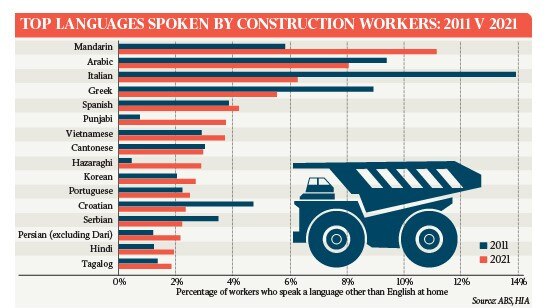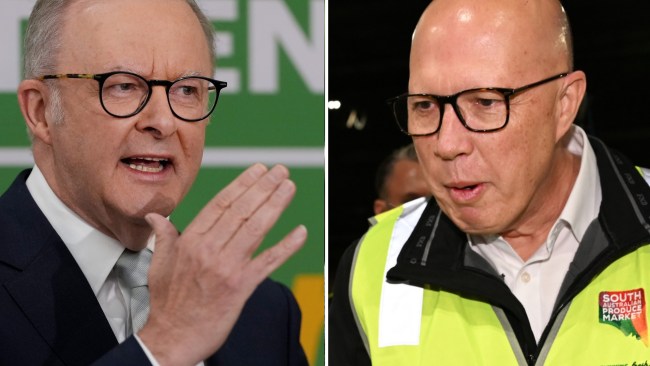Unlock migration for builders or face cost and time blowouts
A surge in Chinese, Korean and Punjabi speaking construction workers and fall in traditional builders have sparked warnings of labour shortages and construction blowouts under current migration settings.

A surge in Chinese, Korean and Punjabi-speaking construction workers and a fall in Italian, Greek, Balkan and Arabic speakers on Australian building sites have sparked warnings of labour shortages and construction cost blowouts under current migration settings.
New analysis of census and industry data shows that unless the Albanese government unlocks new construction migration pathways, Labor’s pledge to build 1.2 million new homes over five years has “little chance” of success.
Housing Industry Association executive director Geordan Murray said despite the building industry commanding 9 per cent of the nation’s total workforce, builders haven’t “been able to attract a proportionate share of the migrant workers who come to Australia”.
HIA analysis reveals a major pivot to Asia, with a 56 per cent increase in construction workers speaking a language other than English.
Between 2011 and 2021, the construction workforce grew 29 per cent, with the number of workers who reported speaking English at home rising by 25 per cent.
Australian Bureau of Statistics census data shows 16.4 per cent of the total construction workforce speaks a language other than English at home, with more than 200 languages and dialects spoken by builders. In line with migration trends, the figures reveal a greater share of migrants arriving from Asia and fewer from Europe.
Mandarin was the most common non-English language spoken in the building industry, with those speaking Italian falling from 13.9 per cent in 2011 to 6.2 per cent in 2021.
Arabic was the second most common non-English language but the share of Arabic-speaking builders declined from 9.4 per cent to 8.1 per cent. Greek-speaking builders fell from 8.9 per cent to 5.6 per cent, while Croatian, Serbian and Macedonian-speaking construction workers dropped out of the top 10 and were replaced by Punjabi, Hazaraghi and Korean-speakers.
Mr Murray, who leads the HIA’s future workforce and industry research unit, said if the construction sector was able to recruit migrant workers proportionate to its 9 per cent share of the workforce, the industry “would have received 40 per cent more migrant workers, over 33,000 additional workers”.

“Successive Australian governments have claimed to oversee a ‘demand-driven’ skilled migration system. Given the acute shortages of skilled workers the construction industry has faced over the last decade, it is implausible to suggest insufficient demand is to blame for this underperformance,” Mr Murray told The Australian.
“The skilled migration system is failing the construction industry. The failure to facilitate skilled migration in the construction industry is enabling labour shortages to continue, which is contributing to longer build times and higher construction costs. Higher construction costs are contributing to fewer homes being built and deteriorating housing affordability.
“Only 24.2 per cent of the construction industry migrated to Australia at some point; this ranks 16th out of the Australia’s 19 major industry sectors. The construction industry is well short of the national average of 32 per cent. The finance and insurance services sector has the largest share of migrant workers at 39.6 per cent.”
The HIA and Master Builders Australia have raised concerns the Albanese government’s migration review failed to address the need for targeted and faster pathways for skilled construction workers.
Mr Murray said despite a “series of reviews, public consultations and the release of the government’s migration strategy, there is little to suggest anything is going to improve the construction industry’s ability to recruit skilled workers from overseas”.
“Without these workers, there is very little chance of building the 1.2 million homes the government aims to deliver over the next five years,” he said.
“The construction industry accounts for 9 per cent of Australia’s total workforce, yet only 6.4 per cent of those who migrated to Australia over the last decade are working in this industry.
“To provide a point of contrast, the accommodation and food service sector account for just 6.6 per cent of Australia’s workforce yet this sector employs 11.4 per cent of migrant workers who arrived in the last decade.
“This sector attracted nearly 80 per cent more migrant workers than the construction industry over the last decade.”
Mr Murray said the increased cultural and linguistic diversity in the construction sector over the past decade “reflects Australia’s success as a multicultural society … much of this cultural and linguistic diversity is from migration … however, the construction industry still rates very poorly when compared to other sectors when it comes to recruiting migrant workers”.
The HIA pre-budget submission to Treasury made three recommendations to simplify the immigration process, including a simplified visa program for in-demand trades, funding to support skilled immigrants navigate jurisdictional licensing requirements and a construction trade contractor visa.




To join the conversation, please log in. Don't have an account? Register
Join the conversation, you are commenting as Logout